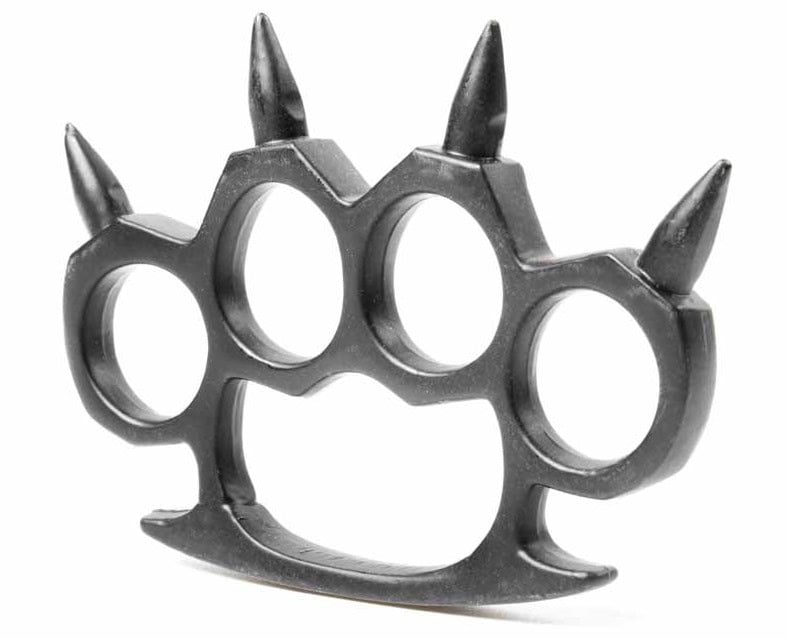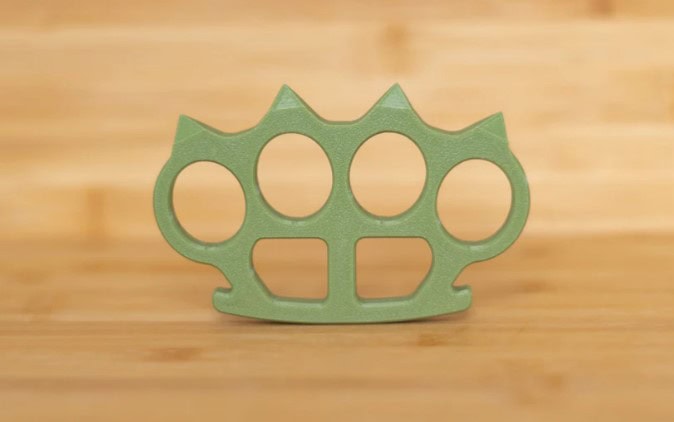What are Spiked Brass Knuckles?
TLDR: Spiked brass knuckles are a modified version of traditional brass knuckles with sharp protrusions designed to enhance their lethality in close combat.
As a weapons enthusiast and martial arts historian, I find spiked brass knuckles to be a fascinating evolution of the traditional hand-to-hand combat tool. These modified brass knuckles, featuring sharp protrusions, represent a significant leap in both design and functionality from their predecessors. In my experience, the addition of spikes transforms the weapon from a blunt force instrument to one capable of inflicting puncture wounds, dramatically altering its combat potential. The history of brass knuckles, dating back to ancient times and evolving through various conflicts, takes an intriguing turn with this spiked variation. While controversial due to their increased lethality, spiked brass knuckles offer unique insights into the ongoing development of personal defense weapons.

Design and Features of Spiked Brass Knuckles
When it comes to the design and features of spiked brass knuckles, there’s a surprising amount of variation and ingenuity to explore. The basic structure typically consists of a set of four connected rings designed to fit over the knuckles, with spikes protruding from the striking surface. In my experience, the placement and number of spikes can vary significantly, affecting both the weapon’s effectiveness and its legal classification in some jurisdictions.
The types of spikes used fall into two main categories:
- Fixed spikes: Permanently attached to the knuckle duster
- Removable spikes: Can be detached or replaced
Personally, I find the removable spike designs particularly interesting, as they offer a level of customization and potentially allow the user to modify the weapon’s appearance quickly.
As for materials, here’s a breakdown of what’s commonly used:
- Base structure:
- Brass (traditional and most common)
- Steel (for increased durability)
- Aluminum (lightweight option)
- Polymer (modern, lightweight alternative)
- Spikes:
- Hardened steel
- Titanium (for high-end models)
In my opinion, the choice of materials significantly impacts the weapon’s weight, durability, and overall effectiveness. While brass remains the classic choice, I’ve seen some impressive modern designs using advanced alloys that offer superior strength-to-weight ratios.
Functionality of Spiked Brass Knuckles
When it comes to the functionality of spiked brass knuckles, we’re dealing with a whole different level of impact compared to traditional brass knuckles. The addition of spikes introduces unique striking methods that can significantly alter the outcome of a confrontation. In my experience studying various hand-to-hand combat techniques, I’ve observed that the spikes enable not just blunt force trauma, but also puncture and tearing capabilities.
Let’s break down the key functional aspects:
- Striking methods:
- Straight punch: Concentrates force on spike tips
- Hooking strikes: Potential for raking or tearing
- Palm strikes: Utilizes the base of the weapon for blunt impact
- Comparison with traditional brass knuckles:
- Increased intimidation factor
- Potential for damage even with glancing blows
- Reduced need for precise targeting of vulnerable areas
The potential for increased damage and injury is, in my assessment, substantially higher with spiked versions. While traditional brass knuckles focus on concentrating force over a smaller area, spiked variants add a penetrating element that can cause more severe tissue damage and potentially life-threatening injuries.
Here’s a quick comparison table:
| Aspect | Traditional Brass Knuckles | Spiked Brass Knuckles |
| Primary damage type | Blunt force | Blunt force + Puncture |
| Effective range | Close | Close to medium |
| Defensive capability | Moderate | High |
| Lethality potential | Low to moderate | Moderate to high |
In my opinion, the functionality of spiked brass knuckles represents a significant evolution in hand-held impact weapons. The combination of blunt force trauma with penetrating injuries creates a more versatile and potentially more dangerous tool.
Legal Status of Spiked Brass Knuckles
The legal status of spiked brass knuckles is a complex and fascinating subject that varies significantly across different regions. In my experience, most countries classify spiked brass knuckles as prohibited weapons. Here’s a brief overview:
Countries where spiked brass knuckles are generally illegal:
- United States (federal law, with some state variations)
- United Kingdom
- Canada
- Australia
- Japan
- Most European Union countries
Regions with more nuanced regulations:
- Some U.S. states allow ownership with restrictions
- Certain Southeast Asian countries have less stringent laws
The consequences of possession and use can be severe, reflecting the weapon’s perceived danger. In my research, I’ve found that penalties often include:
- Fines (ranging from hundreds to thousands of dollars)
- Imprisonment (from months to several years)
- Criminal record
- Confiscation of the weapon
It’s worth noting that in many jurisdictions, the use of spiked brass knuckles in self-defense doesn’t typically qualify as a legal justification for possession. This creates an interesting legal dilemma that I believe merits further discussion in legal and ethical circles.
Here’s a quick comparison of potential consequences in different regions:
| Region | Possession | Use in Crime |
| USA (Federal) | Misdemeanor | Felony |
| UK | Criminal offense | Aggravated offense |
| Canada | Criminal Code violation | Aggravating factor in sentencing |
| Australia | Prohibited weapon offense | Serious criminal offense |
Cultural Impact of Spiked Brass Knuckles
The cultural impact of spiked brass knuckles is a fascinating subject that spans various aspects of society, from media representation to real-world applications. In my years of studying weapon history and pop culture, I’ve observed how these controversial tools have left an indelible mark on our collective imagination.
In media and popular culture, spiked brass knuckles often appear as symbols of toughness and rebellion. They’ve been featured in:
- Movies: Often associated with anti-heroes or villains
- Video games: As collectible items or weapon upgrades
- Music: Referenced in lyrics, especially in punk and hip-hop genres
- Fashion: Incorporated into clothing designs and jewelry
I’ve noticed that their portrayal tends to oscillate between glorification and demonization, reflecting society’s complex relationship with weapons and violence.
The use of spiked brass knuckles in criminal activities versus self-defense scenarios presents an intriguing dichotomy. From my research, I’ve compiled this comparison:
| Aspect | Criminal Use | Self-Defense Use |
| Intent | Premeditated harm | Protection |
| Legality | Typically illegal | Often legally ambiguous |
| Public perception | Negative | Mixed |
| Effectiveness | High in close combat | Potentially deterrent |
In my opinion, the prevalence of spiked brass knuckles in criminal activities has significantly influenced public perception and legal status. However, I believe it’s crucial to acknowledge their potential as self-defense tools, especially in situations where other options might not be available.
Where Can I Get My Own Spiked Brass Knuckles?
If you’re looking to purchase spiked brass knuckles, it’s important to research local laws first, as these items are often highly regulated or prohibited; for those in areas where they’re legal, specialized online retailers and certain self-defense stores may carry them.
Kombativ

Karate Mart

Monkey Knuckles

Final Thoughts
When exploring the rich history of personal defense tools, it’s fascinating to see how innovative designs like spiked brass knuckles compare to other remarkable weapons that have evolved over time. Each weapon, from ancient tools to modern adaptations, reflects a unique blend of functionality and artistry, much like those featured among the coolest weapons in history.
